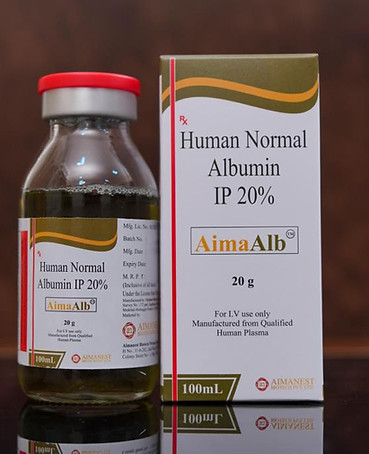

AimaAlb
Product Name:
AimaAlb
Generic Name :
Human Normal Albumin
Strengths:
20% 100 ml and 5% 100 ml.
AimaAlb Human Normal Albumin 20% in 100 ml is a protein prepared from Human Plasma and final product undergoes extensive testing of various protocols; HBsAg, Ab-Ag HIV, anti-HCV by ELISA and for HBV-DNA, HCV-DNA, HAV-RNA, HIV-RNA, Parvovirus B19-DNA by NAT.
Indications
-
Hypovolemic Shock
-
Hypoproteinaemia
-
Haemorrhagic Shock
-
Ascites
-
Burns
-
Plasma Exchange Dialysis
Storage
-
Store between 2°C to 25°C
-
Do not freeze.
-
Protect from light.
Shelf-life
36 months from the date of manufacture
Human albumin is a protein that is naturally present in human plasma. It plays a vital role in maintaining the osmotic pressure of blood, transporting various substances, and regulating fluid balance within the body. Human albumin is widely used in medical and pharmaceutical applications, and its manufacturing process involves several key steps
Plasma Collection: Human albumin is derived from donated human blood plasma. Plasma is collected from healthy blood donors through a process called plasmapheresis. During plasmapheresis, blood is drawn from the donor, and the plasma is separated from other blood components using a specialized machine. The collected plasma is then pooled together from multiple donors to create a larger batch.
Screening and Testing: The collected plasma undergoes rigorous screening and testing to ensure its safety and to minimize the risk of transmitting infectious diseases. Donor plasma is tested for viruses (such as HIV, hepatitis B, hepatitis C), bacteria, and other potential contaminants. Plasma that meets the strict screening criteria is used for further processing.
Fractionation: The pooled plasma is subjected to a process called fractionation, which involves separating the various proteins present in the plasma. Fractionation is typically done using cold ethanol or a similar technique. This process helps to isolate and purify human albumin from other plasma proteins.
Purification: The fractionated plasma is further purified to enhance the albumin content and remove any impurities. This purification step involves various techniques, including filtration, chromatography, and heat treatment. These processes help ensure the quality and purity of the human albumin product.
Stabilization: To enhance the stability of the albumin, it may undergo additional processing steps. These steps can include the addition of stabilizing agents, such as sugars or amino acids, to prevent degradation and maintain the integrity of the protein during storage.
Viral Inactivation/Removal: As an added safety measure, viral inactivation or removal methods are employed to minimize the risk of viral transmission. Techniques such as pasteurization, solvent-detergent treatment, or nanofiltration can be utilized to effectively eliminate or reduce viral contaminants.
Formulation and Sterilization: The purified and stabilized human albumin is formulated into a final product. This involves sterile filtration and, in some cases, adding excipients to enhance stability and shelf life. The final product is then subjected to sterilization methods, such as terminal heat treatment or filtration, to ensure its sterility and minimize the risk of contamination.
Quality Control: Throughout the manufacturing process, extensive quality control testing is conducted to ensure the safety, purity, and potency of the human albumin product. These tests include assessing protein concentration, purity, viral marker testing, and other quality parameters. Only batches that meet stringent quality standards are released for distribution.
Packaging and Distribution: The human albumin product is packaged into vials or bottles suitable for medical use. The packaging includes appropriate labeling with essential information, such as the albumin concentration, batch number, expiration date, and storage instructions. The product is then distributed to healthcare facilities and pharmacies for use in various medical and pharmaceutical applications.
It's important to note that the manufacturing process of human albumin can vary slightly between different manufacturers, but the general steps outlined above provide an overview of the key stages involved. Stringent quality control and adherence to regulatory guidelines ensure the safety, efficacy, and purity of human albumin.